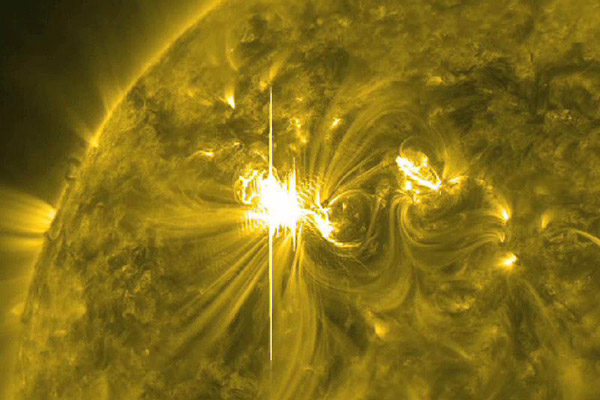
Most interesting news of the day:
The results of the coming geomagnetic storm may be pleasant — auroras as far south as Illinois — or unpleasant, such as GPS and communications problems, according to Young.
[snip]
The coronal mass ejection is expected to hit the Earth at about 1:30 a.m. Eastern time Thursday — with a margin of error of plus or minus seven hours.
The most recent updates suggest that the effects of the geomagnetic storm—imagine taking a bar magnet and waving it at the Earth—won't be anything for most of us to worry about, so we can just comfortably hope that the northern lights will be visible as far south as Illinois. Last October a strong CME passed through, and the results were visible as far south as Arkansas. Someone in Martin, Michigan (not that much farther north than Chicago; it's about on a parallel with the Wisconsin-Illinois border) captured a timelapse:
Here's what it looks like IN SPACE… and it's also a good explanation of the phenomenon. The blast wave rippling across the sun is spectacular:
This one doesn't seem like it'll cause much of a fuss, but in January Lee Billings compellingly outlined a worst-case scenario:
All this may seem like doomsaying, but the historic record suggests otherwise: The Halloween Storm, in fact, pales in comparison to several earlier events. In 1989, ground currents from a less intense geomagnetic storm knocked out a high-voltage transformer at a hydroelectric power plant Quebec, plunging the Canadian province into a prolonged 9-hour blackout on an icy winter night. A far more extreme geomagnetic storm washed over the Earth in May of 1921, its magnitude illustrated in world-girdling aurorae and in fires that broke out in telegraph offices, telephone stations, and railroad routing terminals — sites that sucked up geomagnetic currents traveling through nascent power grids. An even more extreme storm in September 1859 caused geomagnetic currents so strong that for days telegraph operators could disconnect their equipment from battery power and send messages solely via the "auroral current" induced in their transmission lines. The 1859 storm is known as the "Carrington Event," after a British astronomer who witnessed an associated solar flare and connected it with the subsequent earthbound disturbances.
And there's a local connection:
Geomagnetic storms, though, can have less benign impacts. On Aug. 4, 1972, a Bell Telephone line running from Chicago to San Francisco got knocked out. Bell Labs researchers wanted to find out why, and their findings led them right back to 1859 and the auroral current.
Louis Lanzerotti, now an engineering professor at the New Jersey Institute of Technology, went digging in the Bell Labs library for similar events and explanations. Along with field research, the history became the core of a new approach to building more robust electrical systems.
In other SPACE NEWS, the Tevatron is dead but its data lives on:
Physicists from the Fermi National Accelerator Laboratory in Batavia, Ill., say they have found a bump in their data that might be the long-sought Higgs boson, a hypothesized particle that is responsible for endowing other elementary particles with mass.
[snip]
“Based on the current Tevatron data and results compiled through December 2011 by other experiments, this is the strongest hint of the existence of a Higgs boson,” said the report, which will be presented on Wednesday by Wade Fisher of Michigan State University to a physics conference in La Thuile, Italy.
[snip]
It has led to a joke in physics circles now: The Higgs boson has not been discovered yet, but its mass is 125 billion electron volts.



